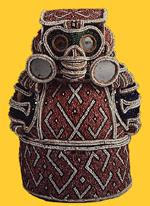
By Tracy Assing
The hammock is sometimes used to illustrate the carefree, relaxed environment one associates with a Caribbean vacation. But that image wasn’t dreamed up by advertising – it’s symbolized the laid-back lifestyle for centuries.
Some sources credit Christopher Columbus with the “discovery” of the hammock when he saw it being used by indigenous peoples during his journey to the Caribbean. First mentioning the hammock in his logs during his first voyage in 1492, he was so impressed by these simple but efficient slings that he took several back to Spain with him.
Although the hammock was revealed to the world in this region, it was also used by Central and South American tribes at the time though it’s said to have spread from the Caribbean only centuries before the Spanish Conquest. The word “hammock” was derived from the Taino hamaca or yamaca, and the first hammocks are thought to have been woven out of tree bark. One of the oldest pieces of furniture in the history of mankind, the hammock has spawned a multi-million dollar industry, with distinctive styles and patterns emerging from different regions.
European explorers were so enchanted by it that they took careful notes of their observations. In an account of life in the West Indies, Gonzalo Fernandez de Oviedo y Valdes wrote in 1535 of the “natives”: The beds in which they sleep are called hammocks that are blankets of cotton well woven of beautiful and good quality fabrics…”
Indigenous tribes were labeled lazy by the conquistadors because they spent so much time in their hammocks, but the visitors were eventually won over by its perfection.
The hammock was lightweight and easy to set up: better than sleeping on the floor, where one could be vulnerable to snakes and damp; and it functioned as a bed, or a chair, or a sack, or a fishing net.
The hammock is not confined to terra firma, though. The English sailors whose efforts helped Britannia rule the waves adopted it in the 16th century, since they found it easier to catch 40 winks in a hammock than on a bunk bed while being tossed around at sea. Centuries later, American astronauts in the Apollo programme snoozed in hammocks between moonwalks.
================================
Getting into a hammock
Turn with your back to the hammock and sit in the sling. As you sit, reach back with your hands to steady yourself and gently spread the bed apart. Once you are in the sitting position, lean back and then pull up your feet.
Getting out
Swing your legs out and then stand up
================================
The hammock is sometimes used to illustrate the carefree, relaxed environment one associates with a Caribbean vacation. But that image wasn’t dreamed up by advertising – it’s symbolized the laid-back lifestyle for centuries.
Some sources credit Christopher Columbus with the “discovery” of the hammock when he saw it being used by indigenous peoples during his journey to the Caribbean. First mentioning the hammock in his logs during his first voyage in 1492, he was so impressed by these simple but efficient slings that he took several back to Spain with him.
Although the hammock was revealed to the world in this region, it was also used by Central and South American tribes at the time though it’s said to have spread from the Caribbean only centuries before the Spanish Conquest. The word “hammock” was derived from the Taino hamaca or yamaca, and the first hammocks are thought to have been woven out of tree bark. One of the oldest pieces of furniture in the history of mankind, the hammock has spawned a multi-million dollar industry, with distinctive styles and patterns emerging from different regions.
European explorers were so enchanted by it that they took careful notes of their observations. In an account of life in the West Indies, Gonzalo Fernandez de Oviedo y Valdes wrote in 1535 of the “natives”: The beds in which they sleep are called hammocks that are blankets of cotton well woven of beautiful and good quality fabrics…”
Indigenous tribes were labeled lazy by the conquistadors because they spent so much time in their hammocks, but the visitors were eventually won over by its perfection.
The hammock was lightweight and easy to set up: better than sleeping on the floor, where one could be vulnerable to snakes and damp; and it functioned as a bed, or a chair, or a sack, or a fishing net.
The hammock is not confined to terra firma, though. The English sailors whose efforts helped Britannia rule the waves adopted it in the 16th century, since they found it easier to catch 40 winks in a hammock than on a bunk bed while being tossed around at sea. Centuries later, American astronauts in the Apollo programme snoozed in hammocks between moonwalks.
================================
Getting into a hammock
Turn with your back to the hammock and sit in the sling. As you sit, reach back with your hands to steady yourself and gently spread the bed apart. Once you are in the sitting position, lean back and then pull up your feet.
Getting out
Swing your legs out and then stand up
================================
Article Source: Caribbean Beat magazine, Sept/Oct 2008, pg 96.










No comments:
Post a Comment